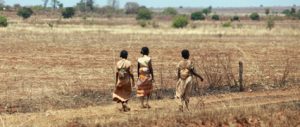Forests have long been a hinterland: remote, “backward” areas largely controlled by external, often urban, actors and seen to be of little use to national development or the world except as a supply of low-valued natural resources. The year 2009 marked the beginning of the end of this era. Forest lands are booming in value for the production of food, fuel, fibre and now carbon. More than ever, forests are bargaining chips in global climate negotiations and markets.
This unprecedented exposure and pressure provides nations and the world at large tremendous opportunity to right historic wrongs, advance rural development and save forests. But the chaos at the United Nations climate conference in Copenhagen laid bare the looming crises that the world will face if long-term trends of ignored rights, hunger and climate change remain inadequately addressed in 2010. While the era of the hinterland is ending, the future of forest areas is not yet clear.
The year 2009 will be remembered for the global economic recession and the chaotic attempts to address climate change. But it might also be remembered as a year when governments were overthrown for ignoring local land rights and there was finally widespread realisation that addressing long-standing questions over forest and land rights and tenure is required for addressing global crises of food security, war and climate change.
In March the government of Madagascar was ousted, a move accelerated by widespread resistance to the government handover of half the island’s arable land to a South Korean corporation, Daewoo Logistics. This reality awoke many to the real political consequences of the volatile combination of insecure land rights, persistent government control of land and forests and booming demand for commodities like food, fuel and speculative forest carbon.
The Copenhagen summit neatly captured the contradictions and challenges of the year. Despite the unclear and limited outcomes, it was one of the most important global negotiations to date and indigenous and other community leaders were organised, influencing global decisions about the future of the planet.
Yet at the end of the summit, these same leaders returned home to forests where many do not have government-recognised rights to the land and trees they have used for generations. The flood of money now promised to their governments to help maintain tropical forests and secure additional carbon is putting unprecedented pressures on forest lands and also offering unprecedented opportunity to secure the rights and development of local people.
Forest communities have long been fighting for more control over their forests. Now, clarifying forest tenure and governance has become a priority for some global leaders and even carbon traders. If, and how, local, national and global actors deal with these issues will determine the future of forest areas.
Today, governments claim to own about 75% of the world’s forests, and just a little more than 9% are legally owned by communities and indigenous peoples. This unbalanced pattern of statutory ownership has begun to change over recent decades but state ownership claims remain particularly dominant in Africa. Latin America has done more to legally recognise the tenure rights of indigenous peoples and forest communities. In fact, at the present rate of change it would take 270 years for the tenure distribution in the Congo Basin to match that of the Amazon Basin.
Tenure transition from state to communities and households is both a reinstatement of traditional governance patterns and a modern development of more equitable governance, rule of law and defence of human rights. It can be peaceful and incremental but, more often than not, it has been confrontational.
The revolutions in Mexico in the early-twentieth century or China in the 1950s, for example, transferred the majority of forests from the state and large landholders to collectives and households. In Europe and the United States, communities and households own the majority of forestlands and in New Zealand and Canada, there are long processes of the indigenous Māoris and First Nations claiming their forest rights. But in a large part of the developing world, state domination over resources put in place during the colonial period has not given way to alternative models and post-colonial legislation continues to assign rights to governments at the expense of local peoples.
Conflicts between forest communities and outsiders are not a new phenomenon. Earlier in history, they were often limited in number and short in duration, with forest communities quickly overwhelmed by an external power. 2009 was different. Just as powerful global investors and national governments realised the enormous potential profit to be made from the remaining tropical forests, violent conflicts in and over forests sparked and raged anew.
Deadly conflicts in Peru and the repression of a longstanding insurgency in India are the most prominent examples but long-overlooked local disputes over resource rights have spun into major conflicts in Afghanistan and the Niger Delta. As the demand to control forest resources increases, so will violent conflict over these valuable resources.
Unready for REDD
As the dust settles from the chaos in Copenhagen, it is clear that REDD, the programme to reduce emissions from deforestation and forest degradation, is going forward with at least US$3.5 billion (23.9 billion yuan) of initial funding but without the framework or standards to guide it responsibly. The combination of new money and limited controls dramatically raises the risks and pressures on forests and forest peoples. The current lack of a comprehensive architecture for REDD means that the carbon market and funding will be global but justice and legal redress will have to be meted out locally.
REDD was held up as one of the rare points of consensus in Copenhagen: promoted by the “global north”, the world’s rich countries, because of the potential for easy and cheap emissions reductions and by the “global south”, or developing countries, for the lure of finance and investment. International programmes like the Forest Carbon Partnership Facility (FCPF) and the UN-REDD Programme were set up to have pilot results ready in time for the Copenhagen summit. But as these pilots got under way, the inherent complications of slowing deforestation came into focus: effective REDD will not be easy. The FCPF and UN-REDD have received donations and pledges of more than US$186 million (1.3 billion yuan) from a handful of governments but only a small fraction of the money has been allocated to actions on the ground to date.
Despite the doubts still haunting REDD, existing REDD-readiness funds have established innovative governance structures that include representatives of indigenous peoples and civil society. This progress cannot be discounted for it hints at the real issues that REDD will encounter in implementation. Yet even where this is recognised, the operational capacity to include local participation and ensure rights recognition in REDD is quite limited.
Where there is value and confusion, there is also high risk of corruption and 2009 may become known as the first year of major carbon crookedness. Just before the climate talks in Copenhagen, the government of Papua New Guinea quietly disbanded its Office of Climate Change and Environmental Sustainability after longstanding and well-publicised accusations that it had illegally sold carbon-ownership certificates valued at AU$100 million (616 million yuan) to an Australian company and egregiously neglected to consult with forest communities – the clear legal owners of the forests of the country.
Last year the widespread lack of legal clarity and enforcement and rising global value of REDD attracted the attention of Interpol, the intergovernmental police organisation, and international environmental crime experts globally. In the words of Peter Younger, environment crimes specialist at Interpol, “The potential for criminality is vast and has not been taken into account by the people who set it up…Organised crime syndicates are eyeing the nascent forest carbon market.”
2010 is the beginning of a new era for the people and forests in developing countries. Northern governments, investors of all ilk and traders of all hues will inspect and vie for forest lands, negotiating, luring and potentially bribing developing country governments – who still lay claim to most forests – to make deals. The era of forest as hinterland is over. Forests will remain remote, but they will be carved up, controlled and used as global political bargaining chips like never before. Work to strengthen local rights, local organisations, and governance is more relevant, and urgent, than ever.
This article is a summary of an original report by the Rights and Resources Initiative, co-authored by Liz Alden Wily, David Rhodes, Madhu Sarin, Mina Setra and Phil Shearman. It is used here with permission.
Homepage image by Erwyn van der Meer



